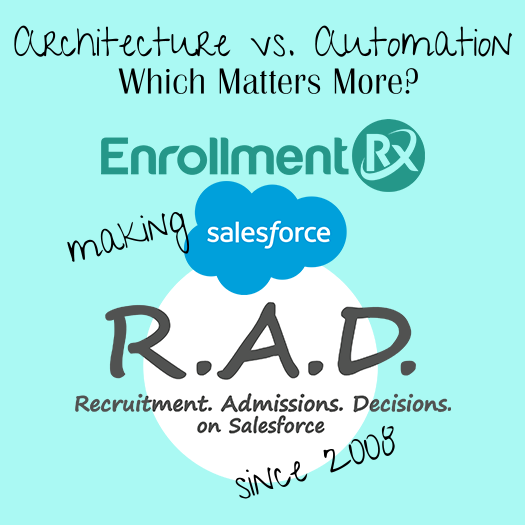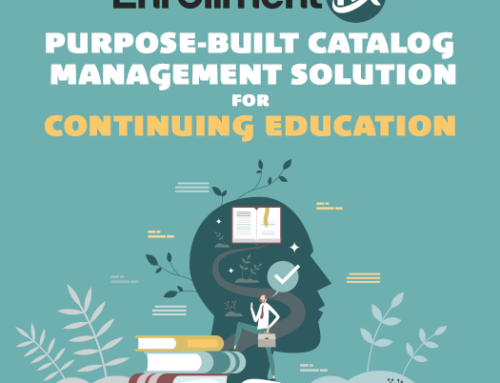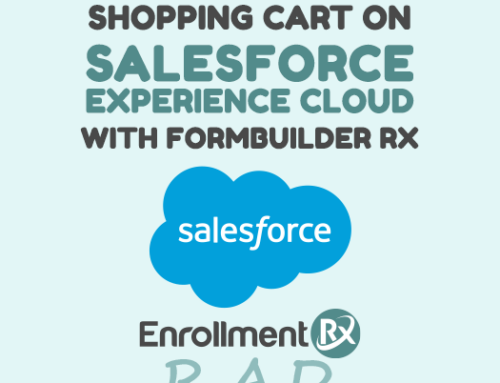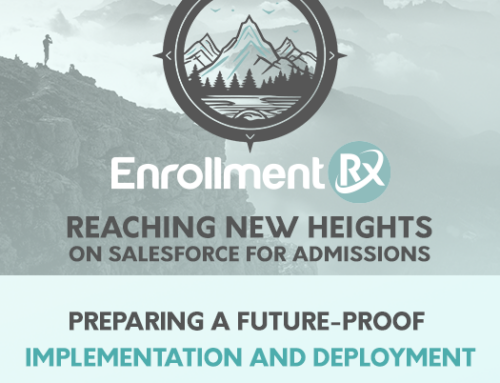When working with Salesforce as your higher education enrollment software for Recruitment, Admissions, and Decisions (R.A.D.), the architecture of your object and data model is very important. After all, Salesforce is an object-oriented database system that relies on a complex structure of relationships and connections between data tables in order to manage mission critical information for various organizations.
In the early stages of Enrollment Rx, we thought that the custom object architecture in our higher education enrollment software should be protected fiercely as intellectual property. Nowadays, we give it away freely. So why the shift in thinking, and what is the actual intellectual property that Enrollment Rx delivers to our clients today?
Let’s first review the necessary architecture to make Salesforce RAD. In the case of higher education enrollment software, if you want to use Salesforce for recruitment and admissions, you most likely would configure/leverage the following object structure:
Salesforce Architecture for Recruitment, Admissions, and Decisions should include the following objects:
- Accounts (Standard Salesforce)
- Contacts (Standard Salesforce)
- Touch Points (Custom)
- Applications (Custom or EDA)
- Checklist Item/s (Custom or EDA) – may look up to both Applications and Contacts
- Feedback (Custom)
After well over 100 projects implementing Salesforce as higher education enrollment software, we can’t think of a better way to architect/manage recruitment and admissions on Salesforce. Any competent Salesforce admin user would be able to configure the above architecture in 5 minutes.
Therefore, the real trick is in the automation. How will the system know to create a new application record? How will the system know to automatically update the appropriate checklist item records for each applicant? How will the system know to make touch point records and automatically update/insert data into new or existing related records? How will the system know to automatically assign ownership of records? These are just some of the questions that will come up in any implementation.
So, what options exist to automate Salesforce? Automation options on Salesforce include:
Workflow: Aside from the fact that the feature will be deprecated by Salesforce in the future, Workflow automationation cannot create related records from related objects. Workflow is limited only to the object that triggers the automation, but cannot create or update other records on other objects.
Process Builder: This feature will also be deprecated by Salesforce in the future. The configuration is cumbersome and operational efficiency is impacted significantly. CPU timeouts can be common.
Flow: This can be less efficient in batch processing compared to Apex code. Also, in order to modify a Flow, one has to clone a version of an existing flow, make modifications, and debug for testing. Flow also requires significant Salesforce expertise.
Custom Apex: This requires professional software development and any changes require sandbox configuration, test class coverage, and final deployment to production. Additionally, deleting custom code can be cumbersome.
Managed Package with built-in controls and automations: It is important to understand that not all managed packages are created equal. One might compare them to cars. Some cars are engineered by the best in the world, and others are engineered as clunkers, destined to be discontinued in the years ahead.
A well-designed managed package should empower operational administrators with the ability to make and modify functionality without the need to employ a team of programmers. At Enrollment Rx, we endeavor to include extensive automations and controls developed specifically for recruitment, admissions, and decisions on Salesforce. These automations provide a mature and well-defined set of features that can all be controlled with clicks-not-code configurations to make Salesforce RAD!
Is it time to finally turn to the experts that are devoted to your R.A.D. success on Salesforce?
Click here to request a demo of our higher education enrollment software solution.




